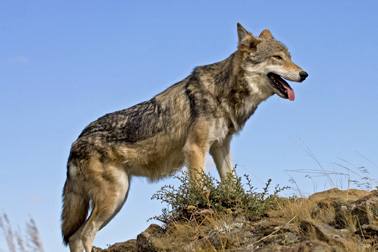 Wolves were once common along the West Coast, from the Olympic Peninsula of Washington state through Oregon to the far reaches of Southern California. As a keystone predator, wolves played a vital natural role in the wild places where they lived, including controlling prey populations like deer and elk. But as people moved in, wolves were forced out. Thankfully, the tide is turning back in wolves’ favor. N early 60 wolves have moved into Oregon and Washington in recent years. And, in late December, one of those wolves made its way into northern California — sparking new hopes that wolves may eventually recolonize some of their historic habitat in the Golden State. That’s why this week, the Center for Biological Diversity and other conservation groups petitioned for gray wolves to be protected under the California Endangered Species Act. Wolves deserve a future in California without being shot and trapped out of existence. Wolves along the West Coast and through most of the West were wiped out in the late 1800s and early 1900s, often by government-funded extermination programs to accommodate the livestock industry. The last wolf in California disappeared around 1924. Americans have come a long way in their attitudes toward wolves. Wolves were returned to the northern Rocky Mountains in the mid-1990s in one of the most important chapters ever written for the Endangered Species Act. There are now more than 1,000 wolves in that region and the population has spilled over to Oregon and Washington where, between the two states, the fledging population now includes about nine packs. The conversation about wolf restoration in the West changed in December when the young male from Oregon’s Imnaha pack arrived in California. Although California is the most populous state in the West, there are still hundreds of square miles of excellent wolf habitat in the northern part of the state and the Sierra Nevada. It’s time to bring wolves back to California and the West Coast — at least in the remote places where there’s good habitat full of plenty of prey, including deer. In returning wolves to the landscape, we return a sense of the wild, something that’s been lost as we’ve cut down forests, paved valleys and created a society that’s increasingly insulated from the natural world. Restoring that wild essence restores something in us, too — just ask anyone who’s heard the howl of a pack of wolves on a frozen morning in Yellowstone. Courtesy of http://www.care2.com/
Wolves were once common along the West Coast, from the Olympic Peninsula of Washington state through Oregon to the far reaches of Southern California. As a keystone predator, wolves played a vital natural role in the wild places where they lived, including controlling prey populations like deer and elk. But as people moved in, wolves were forced out. Thankfully, the tide is turning back in wolves’ favor. N early 60 wolves have moved into Oregon and Washington in recent years. And, in late December, one of those wolves made its way into northern California — sparking new hopes that wolves may eventually recolonize some of their historic habitat in the Golden State. That’s why this week, the Center for Biological Diversity and other conservation groups petitioned for gray wolves to be protected under the California Endangered Species Act. Wolves deserve a future in California without being shot and trapped out of existence. Wolves along the West Coast and through most of the West were wiped out in the late 1800s and early 1900s, often by government-funded extermination programs to accommodate the livestock industry. The last wolf in California disappeared around 1924. Americans have come a long way in their attitudes toward wolves. Wolves were returned to the northern Rocky Mountains in the mid-1990s in one of the most important chapters ever written for the Endangered Species Act. There are now more than 1,000 wolves in that region and the population has spilled over to Oregon and Washington where, between the two states, the fledging population now includes about nine packs. The conversation about wolf restoration in the West changed in December when the young male from Oregon’s Imnaha pack arrived in California. Although California is the most populous state in the West, there are still hundreds of square miles of excellent wolf habitat in the northern part of the state and the Sierra Nevada. It’s time to bring wolves back to California and the West Coast — at least in the remote places where there’s good habitat full of plenty of prey, including deer. In returning wolves to the landscape, we return a sense of the wild, something that’s been lost as we’ve cut down forests, paved valleys and created a society that’s increasingly insulated from the natural world. Restoring that wild essence restores something in us, too — just ask anyone who’s heard the howl of a pack of wolves on a frozen morning in Yellowstone. Courtesy of http://www.care2.com/
Wolves May Be Returning to the West Coast

